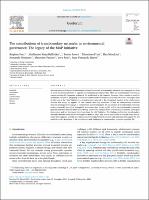Mostrar el registro sencillo del ítem
The contributions of transboundary networks to environmental governance: The legacy of the MAP initiative
| dc.contributor.author | Perz, Stephen | |
| dc.contributor.author | Rioja Ballivián, Guillermo | |
| dc.contributor.author | Brown, I. Foster | |
| dc.contributor.author | Frias, Miroslava | |
| dc.contributor.author | Mendoza, Elsa | |
| dc.contributor.author | Muñante, Armando | |
| dc.contributor.author | Perales, Mercedes | |
| dc.contributor.author | Reis, Vera | |
| dc.date.accessioned | 2023-12-05T21:14:03Z | |
| dc.date.available | 2023-12-05T21:14:03Z | |
| dc.date.issued | 2022 | |
| dc.identifier.uri | https://hdl.handle.net/20.500.12542/3008 | |
| dc.description.abstract | Because many environmental threats span national boundaries, transboundary networks have emerged as a form of multi-stakeholder platform to support environmental governance (EG). There are transboundary networks in various ecologically important regions of the world such as the Amazon. However, there remains a need for systematic analyses to adequately evaluate the contributions of transboundary networks to EG. This paper takes up the case of the “MAP Initiative”, a transboundary network in the tri-national frontier of the southwestern Amazon that sought to support EG. We examine three key questions: 1) how do transboundary networks motivate participants to engage in collaboration across boundaries for EG, 2) how do transboundary networks evolve structurally as well as strategically to increase their impact on EG, and 3) can transboundary networks generate outcomes beyond information sharing for EG? The analysis draws on historical documents, participant observation, and key informant interviews about the MAP Initiative. The findings confirm that transboundary networks motivate cross-border exchanges in multiple ways, they evolve structurally in multiple ways that increase their capacity, and that evolution supports multiple forms of activities and outcomes that support EG. We conclude with a discussion of the contributions and challenges of transboundary networks regarding EG. | es_PE |
| dc.format | application/pdf | es_PE |
| dc.language.iso | spa | es_PE |
| dc.publisher | Elsevier | es_PE |
| dc.relation.uri | https://www.sciencedirect.com/science/article/pii/S0016718521003195 | es_PE |
| dc.rights | Reconocimiento - No comercial - Sin obra derivada (CC BY-NC-ND) | es_PE |
| dc.rights | info:eu-repo/semantics/openAccess | es_PE |
| dc.rights.uri | https://creativecommons.org/licenses/by-nc-nd/4.0/ | es_PE |
| dc.source | Repositorio Institucional - SENAMHI | es_PE |
| dc.source | Servicio Nacional de Meteorología e Hidrología del Perú | es_PE |
| dc.subject | Environmental Management | es_PE |
| dc.subject | Climatología | es_PE |
| dc.title | The contributions of transboundary networks to environmental governance: The legacy of the MAP initiative | es_PE |
| dc.type | info:eu-repo/semantics/article | es_PE |
| dc.identifier.journal | Geoforum | es_PE |
| dc.subject.ocde | https://purl.org/pe-repo/ocde/ford#1.05.09 | es_PE |
| dc.type.sinia | text/publicacion cientifica | es_PE |
| dc.identifier.url | https://hdl.handle.net/20.500.12542/3008 |
Ficheros en el ítem
Este ítem aparece en la(s) siguiente(s) colección(es)
-
Artículo científico [176]








